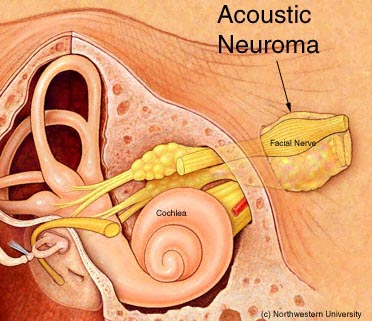As the name suggests, acoustic neuroma is the tumour that develops on the eighth cranial nerve- the one that connects your inner ear to the brain
As the name suggests, acoustic neuroma is the tumour that develops on the eighth cranial nerve- the one that connects your inner ear to the brain. And, because the nerve branches into two parts – one involved in transmitting sound waves and the other associated with our balancing acts, an acoustic neuroma can cause hearing loss, ringing sounds or unsteadiness.
Though uncommon, an acoustic neuroma is a noncancerous and a slow growing tumour. These tumours do not actually invade the brain but they definitely can exert pressure on it as they grow, especially the larger ones that can even cause numbness or paralysis of the face. And, if these tumours grow large enough to press on the brain stem or cerebellum, they may even prove to be life threatening.


It can be difficult to diagnose an acoustic neuroma because its symptoms are so subtle that a lot many times people attribute the symptoms either to middle ear problems or they assume those mild changes as part of ageing. At first, you may have mild symptoms like a gradual loss of hearing in one ear which may or may not be accompanied by ringing sounds. Other symptoms, which may occur over time, include:
* Problems with balance
* Vertigo
* Facial numbness/weakness
* Taste changes
* Difficulty swallowing and hoarseness
* Clumsiness
* Headaches
* Confusion
However, ear exams, hearing tests, and scans can help to diagnose acoustic neuroma.
The two types of acoustic neuroma are- a sporadic form and a form associated with a syndrome called neurofibromatosis type II (NF2).
NF2 is a rare but an inherited disorder characterised by the growth of noncancerous tumours in the nervous system.
There are three main courses of treatment for a patient of acoustic neuroma:
* Observation
* Surgery
* Radiation therapy
Observation or watchful waiting is recommended in cases where the tumour size is small or if it is growing at a slow pace. Often doctors monitor the tumour with periodic MRI scans and they may suggest other treatment if the tumour starts growing in size or it causes other serious or severe symptoms.
Surgery for acoustic neuromas may involve removing all or part of the tumour.
There are three main surgical approaches for removing an acoustic neuroma:
* Translabyrinthine: This involves making an incision behind the ear and removing the bone behind the ear and some of the middle ear. This procedure is used for tumors larger than 3 centimeters.
* Retrosigmoid/sub-occipital: The procedure involves exposing the back of the tumour by opening the skull near the back of the head. This approach is used for removing tumours of any size.
* Middle Fossa: This involves removing a small piece of bone above the ear canal to access and remove small tumours confined to the internal auditory canal, the narrow passageway from the brain to the middle and inner ear.
Apart from these conventional methods, a newer, less invasive technique called total endoscopic resection enables surgeons to remove acoustic neuromas using a small camera inserted through a hole in the skull. This approach has success rates similar to those with the conventional surgery.
Copyright © 2020. All Rights Reserved.
Designed and Developed by Easy Solution 360